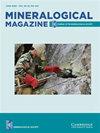Vrančiceite, Cu10Hg3S8, a new Cu-Hg sulfide mineral from Vrančice, Czech Republic
IF 1.4
3区 地球科学
Q2 MINERALOGY
引用次数: 0
Abstract
Abstract Vrančiceite is a new mineral species discovered in a sample collected from the old mine dumps of the abandoned Vrančice deposit near Příbram, central Bohemia, Czech Republic. Vrančiceite occurs as rare anhedral grains, up to 100 μm in size, in a calcite gangue, associated with cinnabar, djurleite, galena and hedyphane. Vrančiceite is black, with metallic lustre. Mohs hardness is ca. 2–3, calculated density is 6.652 g.cm–3. In reflected light, vrančiceite is light grey with a yellowish shade; bireflectance, pleochroism and anisotropy are all weak. Internal reflections were not observed. Reflectance values for the four Commission on Ore Mineralogy wavelengths of vrančiceite in air [Rmax, Rmin (%) (λ in nm)] are: 33.6, 31.2 (470); 33.9, 30.6 (546); 31.1, 30.0 (589); and 32.1, 29.1 (650). The empirical formula, based on electron-microprobe analyses, is Cu10.11(4)Ag0.01(1)Hg2.87(4)Sb0.01(1)Bi0.01(1)S7.99(8). The ideal formula is Cu10Hg3S8 (Z = 2), which requires (in wt.%) Cu 42.54, Hg 40.29 and S 17.17, total 100.00. Vrančiceite is triclinic, P$\bar{1}$, with unit-cell parameters a = 7.9681(2), b = 9.7452(3), c = 10.0710(3) Å, α = 77.759(1), β = 76.990(1), γ = 79.422(1)°, V = 737.01(4) Å3 and Z = 2. The strongest reflections of the calculated powder X-ray diffraction pattern [d, Å (I) hkl] are: 3.354 (76) $\bar{2}$01, 3.111 (68) 222, 2.833 (100) 213, 2.733 (93) 231, 2.705 (76) 2$\bar{2}$1 and 2.647 (71) $\bar{2}\bar{1}$2. According to the single-crystal X-ray diffraction data (R1 = 0.0262), the crystal structure of vrančiceite can be described as comprising Cu–S layers, connected through CuS3 polyhedra, giving rise to a three-dimensional framework with channels running along the a axis and hosting linearly coordinated Hg atoms. Structural relations with gortdrumite are discussed. Vrančiceite is named after its type locality, the Vrančice deposit near Příbram. The mineral and its name have been approved by the Commission on New Minerals, Nomenclature and Classification of the International Mineralogical Association (IMA2022–114).Vrančiceite,Cu10Hg3S8,一种来自捷克共和国Vranćice的新型铜汞硫化物矿物
本文章由计算机程序翻译,如有差异,请以英文原文为准。
求助全文
约1分钟内获得全文
求助全文
来源期刊

Mineralogical Magazine
地学-矿物学
CiteScore
4.00
自引率
25.90%
发文量
104
审稿时长
6-12 weeks
期刊介绍:
Mineralogical Magazine is an international journal of mineral sciences which covers the fields of mineralogy, crystallography, geochemistry, petrology, environmental geology and economic geology. The journal has been published continuously since the founding of the Mineralogical Society of Great Britain and Ireland in 1876 and is a leading journal in its field.
 求助内容:
求助内容: 应助结果提醒方式:
应助结果提醒方式:


